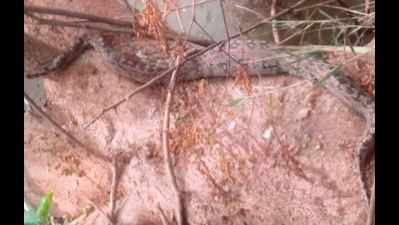- News
- City News
- chandigarh News
- Rich pickings for pythons in Sukhna's watery tree grave
Trending
This story is from November 21, 2017
Rich pickings for pythons in Sukhna's watery tree grave

A Rock python with ingested prey rests along a fallen tree lying in the water at Bird Walk, Sukhna Lake
CHANDIGARH: The intense surge of water at the Sukhna Lake's regulator end following the late monsoon rains resulted in an unusually high number of trees falling into the water. But that green fall from the embankment slopes had the mighty Indian rock pythons smacking their lips as it brought the feathered denizens of the high branches well within reach of these serpents.All the pythons did was lay night ambushes along the trunk and branches lying horizontal in the water and grab unsuspecting wetland birds, which were earlier out of reach.
Birds like cormorants, egrets and pond herons were perching, roosting and basking on the fallen branches. Water hens also darted hither and thither in the water and foraged among fallen branches.
An estimated 9-feet-long python was observed at the far end of the Bird Walk on Monday morning after having ingested a prey, which is most likely to have been a wetland bird from the contours of the conspicuous bulge in the python's belly. The python was lying dormant along the trunk of a tree that had fallen into the water with its roots still anchored in the embankment wall. Another python, bigger in size, was observed by Sukhna's forest guards for two consecutive days thrashing about and coiling/uncoiling in the water after having ingested a big-sized prey.
Reptile expert Nikhil Sanger has rescued, undertaken prolonged captive care and subsequently rehabilitated dozens of pythons. According to Sanger, pythons also hunt by laying ambushes along embankments and prey on birds that dwell in bushes that take root along receding waterlines. "After ingesting prey, pythons prefer sliding into water and they thrash about for a prolonged period as it helps digestion and passing stool. If the ingested prey is very big, the python will not prefer slithering along the jungle floor as it will prick and tear at the enlarged belly. The python's heavy belly is buoyed up and cooled by water. During digestion, pythons will periodically open and close their jaws to restore them to their normal places as ingestion of prey puts a lot of strain on the jaws. The python has the ability to swallow prey much bigger than its skull," Sanger told TOI.
Birds like cormorants, egrets and pond herons were perching, roosting and basking on the fallen branches. Water hens also darted hither and thither in the water and foraged among fallen branches.
An estimated 9-feet-long python was observed at the far end of the Bird Walk on Monday morning after having ingested a prey, which is most likely to have been a wetland bird from the contours of the conspicuous bulge in the python's belly. The python was lying dormant along the trunk of a tree that had fallen into the water with its roots still anchored in the embankment wall. Another python, bigger in size, was observed by Sukhna's forest guards for two consecutive days thrashing about and coiling/uncoiling in the water after having ingested a big-sized prey.
Reptile expert Nikhil Sanger has rescued, undertaken prolonged captive care and subsequently rehabilitated dozens of pythons. According to Sanger, pythons also hunt by laying ambushes along embankments and prey on birds that dwell in bushes that take root along receding waterlines. "After ingesting prey, pythons prefer sliding into water and they thrash about for a prolonged period as it helps digestion and passing stool. If the ingested prey is very big, the python will not prefer slithering along the jungle floor as it will prick and tear at the enlarged belly. The python's heavy belly is buoyed up and cooled by water. During digestion, pythons will periodically open and close their jaws to restore them to their normal places as ingestion of prey puts a lot of strain on the jaws. The python has the ability to swallow prey much bigger than its skull," Sanger told TOI.
Pythons do not kill prey by immediately coiling around the target. "A python lunges for the prey and catches it by the neck with its teeth. After that, the python subdues the prey by weighing it down with heavy coils while retaining grip on the prey's neck. Once the prey is imprisoned under the weight, the python starts to coil around the prey," explained Sanger. The tightening coils compress the prey's thoracic cavity, preventing ventilation and impeding cardiac output and blood flow to and from the head. After death, the prey is swallowed slowly head first by the python. However, young pythons, who often feed on small bush birds, need not coil every time to kill. They can just grab the small bird with the jaws and swallow it. If the bird or any other prey struggles, the python can resort to crusher coiling to ensure the creature's death.
End of Article
FOLLOW US ON SOCIAL MEDIA










